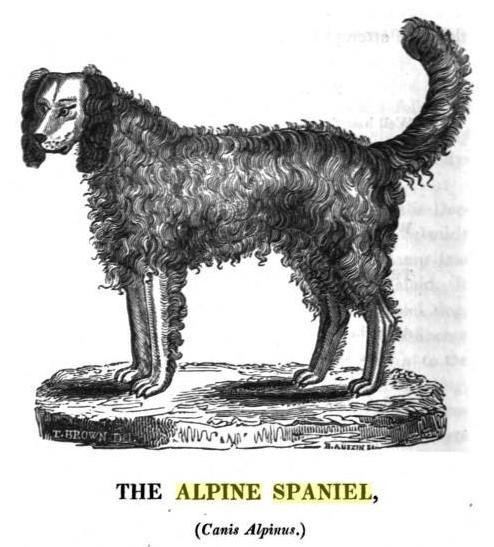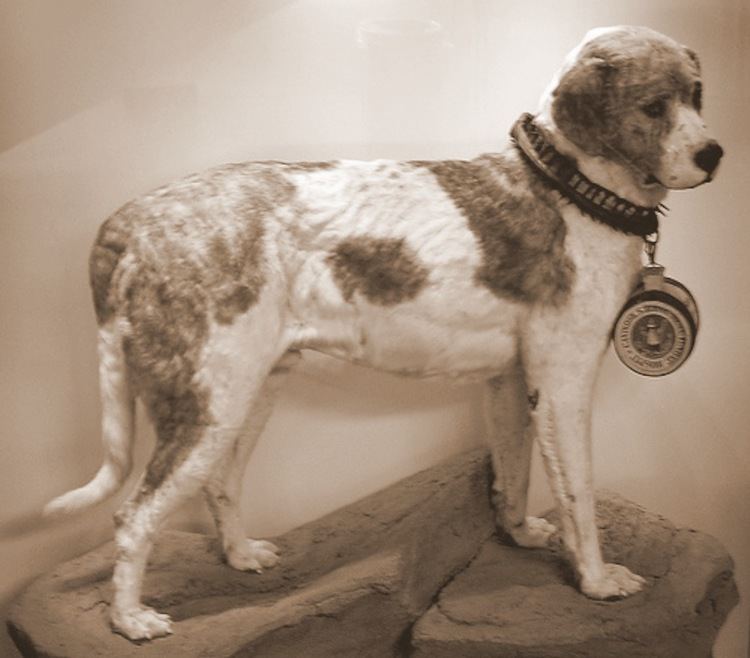Breed status Extinct Countries of origin Switzerland, Savoy | Higher classification Dog | |
 | ||
Other names Alpine Spaniel of St.Bernard
Bernardine Dog Similar Dog, Blue Paul Terrier, Armant, English Water Spaniel, Norfolk Spaniel | ||
The Alpine Spaniel is an extinct breed of dog which was used in mountain rescues by the Augustinian Canons, who run hospices in the region around the Great St. Bernard Pass. The spaniel was a large dog notable for its thick curly coat. One of the most famous specimens of the Alpine Spaniel is Barry, however his preserved body has been modified on more than one occasion to fit with descriptions of the extinct breed from earlier time periods. Due to the conditions in the Alps, and a series of accidents, extinction was discussed as a possibility by authors during the 1830s, and at some point prior to 1847 the entire breed was reduced to a single example due to disease. Evidence held at the Natural History Museum in Bern show that two distinct breeds of dog were being used in the area during this time period. The breed is thought to be the predecessor to the modern St. Bernard and the Clumber Spaniel.
Contents

Description

The Alpine was a large breed of spaniel, described as reaching two feet at the withers and six feet from the nose to the tail. It had a closely set coat, curlier than that of the English Cocker Spaniel or the English Springer Spaniel. An intelligent breed, it was particularly adapted to the climate of the Swiss Alps.

Old skulls in the collection of the Natural History Museum in Bern demonstrate a diversity in head shapes. The collection proves at least two distinct variations during the same time period. The larger skulls have a greater pronounced stop with a shorter muzzle while the smaller skulls show a great deal less stop whilst having longer muzzles.
History

Alpine spaniels were kept by the canons of the monasteries in the Alps in order to search for travellers during heavy snow storms, including the Great St. Bernard Hospice in the Great St Bernard Pass between Italy and Switzerland. The dogs would be dispatched in pairs to search for fallen travellers, and were trained so that upon finding them would return to the canons in order to lead rescuers back to the unfortunate individuals. The Alpine breed was also used as a watchdog to guard sheep and cattle of mountainous regions, including the Himalayas.

Between 1800 and 1814, a dog named Barry lived as a rescue dog at the hospice, and was famous enough at the time for his body to be preserved at the Natural History Museum of Bern. However, during the preservation, the taxidermist and the director of the Museum agreed to modify the body towards what they thought was a good example of the breed during that period. The head itself was further modified in 1923 to represent the Saint Bernard of that era. Prior to this the skull was a great deal flatter with a moderate stop.
In 1829 a Mastiff like dog was brought from the Great St Bernard Hospice and was exhibited in London and Liverpool to thousands of people. This publicised the existence of an Alpine Mastiff, but drawings of the dog did not match descriptions of the Alpine Spaniel from before the exhibition, and the descriptions of the Spaniel were ridiculed by later publications.
Because of the treacherous conditions in which this breed of dog was used, coupled with a succession of accidents, talk of the whole stock becoming extinct was raised as early as 1839. However at some point prior to 1847 a pestilence swept through the region and reduced the number down to a single specimen, which forced the canons into crossing it with other breeds.
St. Bernard
The Alpine Spaniel was one of the direct genetic progenitors to the St. Bernard. Starting in 1830, the monks and canons of the Swiss Alps began crossing the dogs with the Newfoundland, expecting that the resulting offspring would have the longer hair of the Newfoundland and this would protect the dogs better from the cold. Unfortunately ice would form on the longer hair, and seeing that the dogs were no longer effective rescue dogs, the monasteries gave them away to people in the surrounding Swiss valleys.
In 1855 a stud book was opened for these crosses, which supplied the hospice with suitable dogs and also exported the dogs overseas. Many people began breeding them indiscriminately, which resulted in their modern appearance. By 1868, the breed was commonly being referred to as the "Saint Bernard Dog" first and the Alpine Spaniel second.
Clumber Spaniel
It is thought that the Clumber Spaniel originated in 18th century France from the Basset Hound and the Alpine Spaniel. The name "Clumber" itself comes from Clumber Park, Nottinghamshire.
